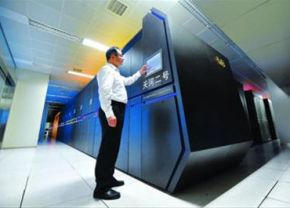Tianhe-2 supercomputer
The Tianhe-2 (天河二号), developed by China's National University of Defense Technology, is now the world's fastest supercomputer, international supercomputer organization Top 500 announced in Germany on June 17, 2013.
The Tianhe-2, or Galaxy-2, supercomputer is capable of continuously performing 33.86 petaflops per second, with a peak performance of 54.9 petaflops per second. It has overtaken Titan, installed at the U.S. Department of Energy's Oak Ridge National Laboratory, which now ranks second with a performance of 17.59 petaflops per second.
This is the second time China has ranked first in the Top 500 list of the world's most powerful supercomputers. Its Tianhe-1 was the world's fastest supercomputer from November 2010 to June 2011, when it was surpassed by Japan's K computer with a performance of 10.51 petaflops per second.
Compared with the Tianhe-1, the Tianhe-2 has made a series of major breakthroughs in system structure, calculating array, high-speed Internet, storage framework, program model, fault management, energy consumption control, high density and precision architecture. The latter's peak and continuous performing speed has increased by more than ten times.
Costing US$100 million and requiring 280 in technical staff, the Tianhe-2 is expected to be operational at the supercomputer center in Guangzhou before the end of 2013. It will serve the Pearl River Delta area and Hong Kong and Macao regions. At present, staff training and construction of engine rooms are underway.
